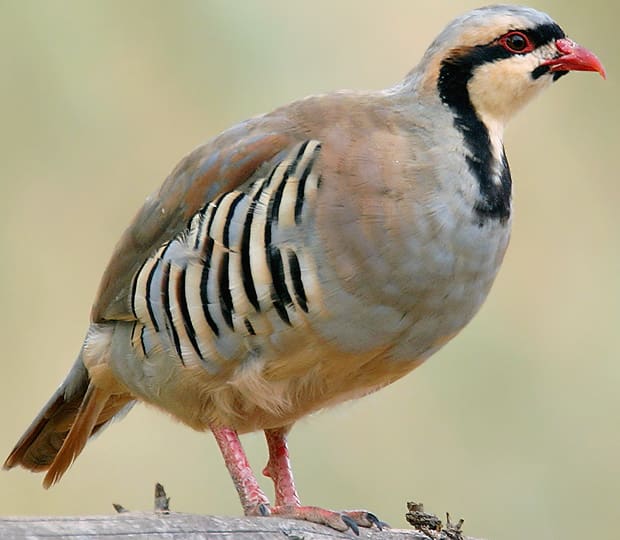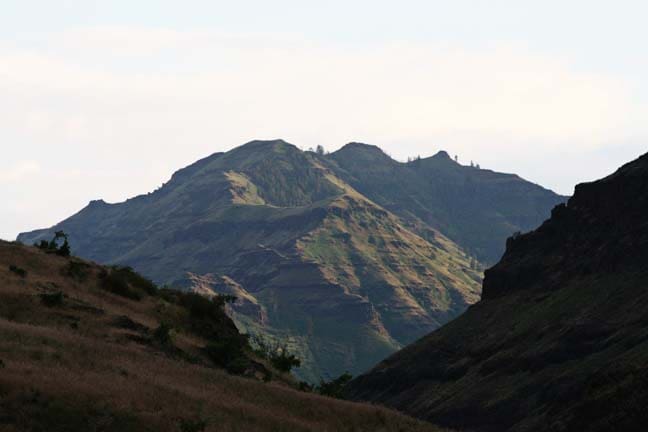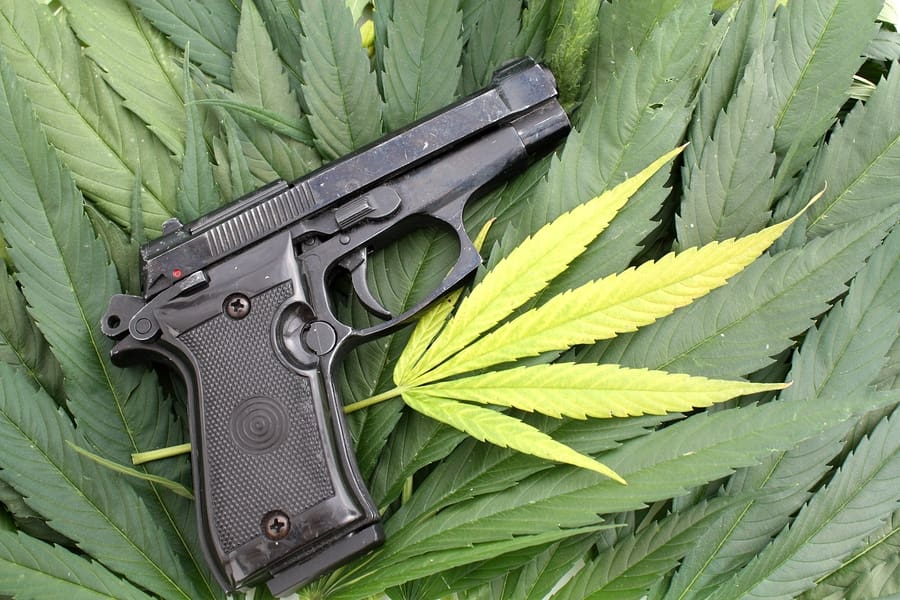By Tom in Oregon
Recently, Tyler Kee posted a story about dove hunting in Texas. While reading it, I started getting excited about an upcoming bird hunt I get to participate in. Mind you, this is while I’m in the middle of bear hunting, while also looking forward to elk season in December and another trip back to Africa for more plains game. You see, I am a hunter. As noted hunter and conservationist Jim Shockey has said, “If I’m not hunting, I’m thinking about hunting.” I take that a little farther. Even when I’m hunting, I’m thinking about hunting . . .
When I eat what I harvest, it holds a very special meaning and every bite is savored. Tyler’s recipe using quail breast with cream cheese-stuffed jalepeño wrapped in bacon is my absolute favorite. Though something simple like “chukar noodle soup” is nice on a fall day. Chukar breast marinated in a good teriyaki sauce, barbecued, then laid on a bed of wild rice is excellent and simple.
Upland bird season opens on October 11here in Oregon. Due to varying days off, our group will be heading east on the 19th. That means I need to put a bit more effort into building my stamina and leg strength as our group heads off to the Snake River canyon for the elusive chukar.
This wily bird is in the partridge family and is a bit larger than quail. While normally in coveys like quail, they don’t always rely on a group mentality to stay alive. They are a very fast bird with a high regard for their own survival. Normally, the birds aren’t too skittish in the opening weeks. Yet as the season progresses, they will flush for no reason. Normally, we scout an area and see if we should start at the top of the mountain or the bottom, based on where we hear the birds. That is, from what level in the deepest canyon in North America are these champions of survival mocking us? They “chuck chuck chuck chukar” at you from a cliff face at some level and it echoes off of the rim rock, somewhere in this…
If we’re lucky, they will be close to the top, or close to the bottom. If they’re in the middle, it’s going to be a long day, and I start to wonder if I remembered to bring ibuprofen for the next morning.
Mind you, these birds are the supreme sadists of the hills. But only because we are the ultimate masochists. We will chase them half way up the hills, only to have them turn around, side hill, then fly back down. Or conversely, chase them half way down the hills only to have them fly back to the top. Lather, rinse, repeat.
Boots ‘N Guns
The correct tools are a definite must. Good-fitting, well worn boots with ankle support are at the top of the list. Between the shale, decomposing granite and columnar basalt that has broken and collected into the random scree field, the going can be rough on the ankles. And if you show up wearing new boots, you’ll get pity laughs. Check that, we’re going to laugh our asses off! Because we know you won’t be hunting day on day two, three or four. You’ll be nursing blisters. Which means you better know how to cook, because you are now the “camp b!tch.”
Normally, we wear a hunting vest in blaze orange. You have to wear a vest anyway for carrying your shells and hopefully, a few birds. Orange is helpful in keeping track of everybody in a rapidly disintegrating skirmish line. As safety is a must, we all carry GMRS radios for check in. They are checked pre-hunt to make sure they all work and have good batteries.
For a proper shotgun, the guys in our group have quite the eclectic mix. One has an old Remington 1100, another has a beautiful Ruger red label over and under. One carries a Benelli M-1 super 90 with a plug. Only one in our group carries a pump gun. I rotate between an older Browning Silver Pigeon over/under in 12 gauge or a really old Winchester model 50 auto loader in 20 gauge.
Auto loaders prevail here. There’s a definite need for speed in your shooting when a covey flushes and no amount of trap, skeet, or sporting clay shooting will prepare you for an explosion of feathers as the birds explode into the sky. As they take flight, they launch straight up for about five feet, just two feet above the sage brush. Then they turn for level flight and vacate into the next time zone.
If you’re good, you’ll get one of them in their initial launch. If you are pretty good at trap, skeet or sporting clays, you’ll get a double. If you’re really good, you’ll get a third as it levels out and approaches warp speed. I’ve gotten a few doubles. I’ve only seen one triple. Most times, in all the confusion, you shoot into the covey — instead of aiming at a particular bird — and miss every darn one of them. A full choke is also a must. Some shots will be really out there … 75-100 yard shots at a straight away bird can be done.
Ammo and other Necessaries
The weather there can flip you off with the fickled finger of fate. One day it’s near 70 and you’re in shirt sleeves. A week or two later and it’s just above zero, so the clothing rule of thumb is “bring everything.”
As for ammo, all of us have settled on high base #6 shot. Three-inch shells are kind of overkill, 2 3/4 work just fine. I usually carry two full boxes on a hike. This, on top of a couple bottles of water, a small first aid kit, a couple of energy bars and if you’re lucky, a six bird limit of delicious winged protein on the hike back. Remember, ounces turn into pounds on a 5-10 mile, 6-8 hour hike up and down that kind of terrain.
That’s my ride back to camp. It’s a 20′ boat with two friends taking a fishing break while I chase more birds. Because this is where I like to shop for groceries. Because I’m a hunter.








I’m a hunter, also. Just not a very good one. Tomorrow opens quail season here. I get to see how bad I suck at CA quail.
But I love every minute of the hunt.
Tom, great article, you rock as a writer.
Have a good hunt, and looking forward to the after action.
Chukar hunting is some of my very favorite hunting, but I’ve done most all of mine in northern Nevada.
It is not for the physically unfit, nor those who don’t have good balance.
The one thing we used to tell outsiders who came into rural Nevada on chukar hunting is to bring a shotgun that a) works and b) they won’t cry over when (not if) they drop it or roll it down the hill.
I’ve seen grown men in the local bar, wailing and crying about what had happened to their really nice O/U or double gun at the end of a day of chukar hunting. My A390 is covered with abuse from chukar hunts. It is the only gun I take chukar hunting, because once it got dropped down the side of a mountain into a scree chute, there was no point in worrying about it.
My hunting buddies and I, like you, settled on #6 shot at the beginning of the season, many some of us would switch to #5’s and tighter chokes towards the end of the season in January when the birds started flushing further out.
Other tidbits:
– learn to shoot at falling targets. Chukar like to run uphill ahead of you, and when they get to a good point, they will launch, lock their wings and glide downhill. You need to shoot under them, and therefore need to practice a declining shot.
– they like coming to water in the later morning (9 to 10) and then will climb back up the slope during the day, especially later in the season.
– hunting them over snow makes forces them down to lower elevations later in the season.
– late in the season, look for new growth of cheatgrass. They positively love newly sprouted cheat on southern-facing slopes for food going into winter.
– when the birds flush, take the extra step if you’re out of position. eg, if you’re a right-handed shooter, take the extra time to step forward with your left foot, get into a more stable shooting position, and then start nailing them. This one thing helped my chukar wing shooting more than anything else.
In chukar country, you need to pack your own water. Most of the water you will come across will not be fit for drinking without filtration, and even then (at least in Nevada) much of the water will be rather off-tasting, due to mineralization.
Chukar are another one of those really well-adapted, introduced species in the west. They were brought back from what is now Pakistan in the 30’s by a rancher in Nevada, and they took off from there. They’re best adapted to the Great Basin, with some populations in central/western WY, eastern ID, UT, etc. from US 6 up to the Snake River is perhaps the best area for chukar hunting.
Chukars really are sadistic little buggers. In addition to being ventriloquists with their Chuck Chuck Chucking, they can run about as fast as a deer, so will often stay just out of reach ahead of you, without ever flushing. They also have that departing call as they fly away, which sounds suspiciously like, “Chuck you, chuck you, chuck youuuuu….”
Someone once told me that the first time you hunt them is for fun; every time after that is for revenge
Ha! Quite so.
We’ve had several new guys join us. Most never come back. We joke that there are two types of chukar hunters….
Those who are,
And those who never will again.
GREAT PIECE OF WRITING! Super excited to see you’re getting out there in the woods. I’m starting to get the itch again.
As someone who has never hunted, I now want to hunt.
So, after seeing you comment about chukar twice at least, I had to do some google-fu, and now theres an article too! Great stuff, Id love to get to eat one of these little guys some day, looks like you would get a decent sized breast from em.
In recent years, so I dont have to wear a vest or if you have one you really like and dont want to funk it up,
( and ironically to help reduce the shrine of walmart bags growing inside my pantry) Ive been tying a walmart bag to one of my belt loops to hold my birds when mobile. Easy to untie and hang on a tree when you get back to your hunting chair/spot, the bag works pretty well for all the mess after cleaning your birds also.
“approaches warp speed” – Engage!
Damn Tom, that looks awesome. Frigging beautiful landscape out there. I’m way jealous. Great post man. Now I’m starting to think of ways i can make an excuse to visit the uncle in Portland…
I’ve hunted chukar in the Texas Hill Country many times with my father and it puts dove and pheasant hunting to shame. The birds I’ve hunted are all pen-raised due to the hotter climate, but they are awesome to eat. I’ve put hunting them “up north & west” on my bucket list, using my beat-up weapon of choice: a Beretta 390 semi-automatic.
Tom, thank you for sharing! Dove season opens soon here in north Florida. Time to dust off the ’54 Sweet Sixteen!
Oh man The Snake river is my backyard!, I Hunt ice harbor dam, clear up to Little goose… Chukars tore up my chessie pretty good.. Excellent read Tom…Gotta love this part of the Country…
Tom, your stories make me miss living in Oregon even worse! I envy you. I’ll have to see about hunting here in NC next month.
I’ve been in that Snake River country, and as a flat-lander from SD, I will happily stick to pheasants and sharp tails! Beautiful country, but I would never survive the walk. Great story!
“Mind you, these birds are the supreme sadists of the hills. But only because we are the ultimate masochists. We will chase them half way up the hills, only to have them turn around, side hill, then fly back down. Or conversely, chase them half way down the hills only to have them fly back to the top. Lather, rinse, repeat.”
As a friend once told me, “the first time you go after Chukar, you are hunting them. The second time it’s for revenge.”
You can actually hear them laughing as they fly nap-of-the-earth downhill, from just out of range.
Comments are closed.